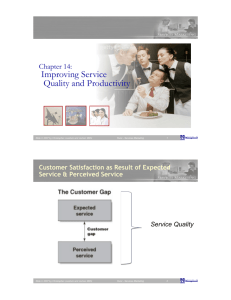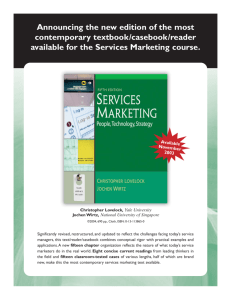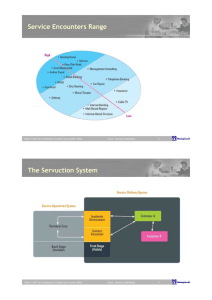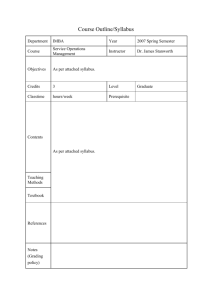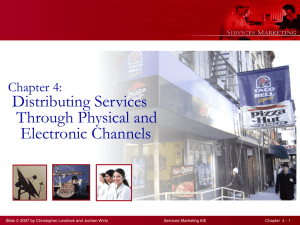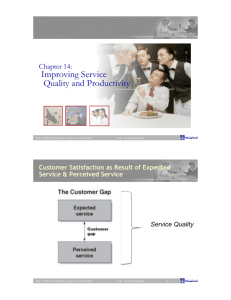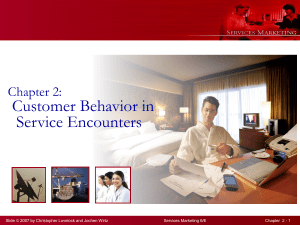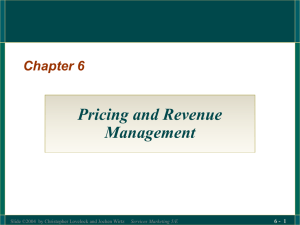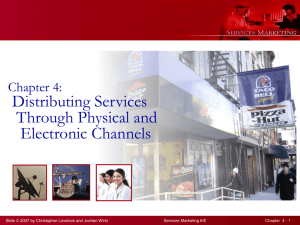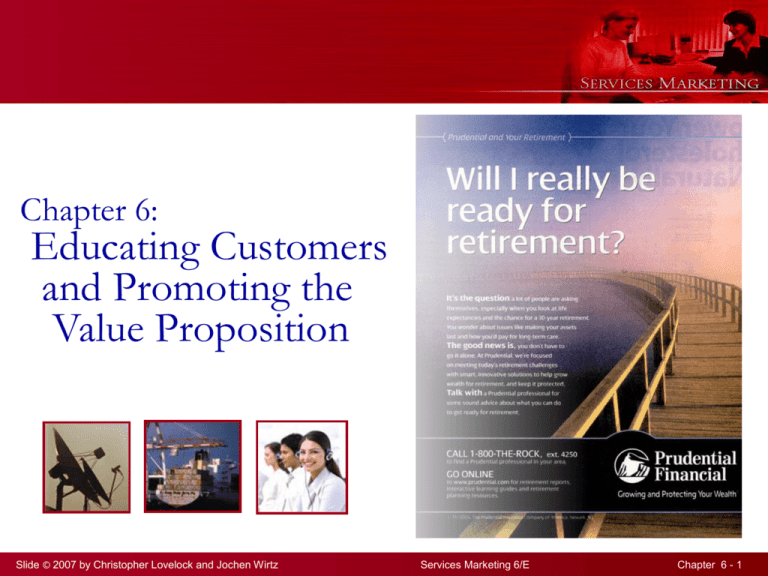
Chapter 6:
Educating Customers
and Promoting the
Value Proposition
Slide © 2007 by Christopher Lovelock and Jochen Wirtz
Services Marketing 6/E
Chapter 6 - 1
Overview of Chapter 6
Role of Marketing Communications
Communicating Services Presents Both Challenges and
Opportunities
Setting Communication Objectives
The Marketing Communications Mix
Role of Corporate Design
Marketing Communications and the Internet
Slide © 2007 by Christopher Lovelock and Jochen Wirtz
Services Marketing 6/E
Chapter 6 - 2
Adding Value through
Communication Content
Information and consultation represent important ways to add
value to a product
Provide information to prospective customers
Service options available, cost, specific features, functions, service
benefits
Persuade target customers that service offers best solution to
meet their needs and build relationship with them
Help maintain relationships with existing customers
Requires comprehensive, up-to-date customer database and ability
to make use of this in a personalized way
Direct mail and contacts by telephone, e-mail, websites, text
messages
― For example, doctors sending annual checkup reminders to patients
Slide © 2007 by Christopher Lovelock and Jochen Wirtz
Services Marketing 6/E
Chapter 6 - 3
Overcoming Problems of Intangibility
May be difficult to communicate service benefits to
customers, especially when intangible
Intangibility creates four problems:
Abstractness
― No one-to-one correspondence with physical objects
Generality
― Items that comprise a class of objects, persons, or events
Nonsearchability
― Cannot be searched or inspected before purchase
Mental impalpability
― Customers find it hard to grasp benefits of complex,
multidimensional new offerings
Slide © 2007 by Christopher Lovelock and Jochen Wirtz
Services Marketing 6/E
Chapter 6 - 4
Advertising Strategies for
Overcoming Intangibility (Table 6.1)
Intangibility problem Advertising strategy
Generality
objective claims
Document physical system capacity
Cite past performance statistics
subjective claims
Present actual service delivery incident
Nonsearchability
Present customer testimonials
Cite independently audited performance
Abstractness
Display typical customers benefiting
Impalpability
Documentary of step-by-step process,
Case history of what firm did for customer
Narration of customer’s subjective experience
Source: Banwari Mittal and Julie Baker, “Advertising Strategies for Hospitality Services,” Cornell Hotel and Restaurant Administration Quarterly 43, April
2002, 53
Slide © 2007 by Christopher Lovelock and Jochen Wirtz
Services Marketing 6/E
Chapter 6 - 5
Using Metaphors to
Communicate Value Propositions
Tangible metaphors help to communicate benefits of
service offerings, for example:
Allstate—“You’re in good hands”
Prudential Insurance—uses Rock of Gibraltar as symbol of
corporate strength
Metaphors communicate value propositions more
dramatically and emphasize key points of difference
Highlight how service benefits are actually provided
Can you suggest some examples from recent advertising?
Slide © 2007 by Christopher Lovelock and Jochen Wirtz
Services Marketing 6/E
Chapter 6 - 6
AT Kearney: Using Bear Traps as
Metaphors for Problems (Fig 6.3)
Emphasizes that firm includes all
management levels in seeking
solutions
Ad shows bar traps across office floor
Headline: “What Did Your
Consultants Leave Behind” raises
doubts about services of other
suppliers
Message: Avoid problems caused by
consulting firms that work only with
top management
Draws attention to how AT Kearney
differentiates its service through
careful work with “entire team” at
all levels in client organization, thus
making recommendations easier to
implement
Source:”What Did Your Consultants Leave Behind,” Copyright A.T. Kearney. All
rights reserved. Reprinted with permission
Slide © 2007 by Christopher Lovelock and Jochen Wirtz
Services Marketing 6/E
Chapter 6 - 7
DHL: Promoting the Efficiency of
Its Import Express Service (Fig 6.4)
Use of an easily grasped
metaphor
Heavily knotted string represents
how complex importing can be
Straight string represents how
easy it would be using DHL’s
express service
Source: Courtesy DHL Express Singapore
Slide © 2007 by Christopher Lovelock and Jochen Wirtz
Services Marketing 6/E
Chapter 6 - 8
Facilitate Customer Involvement in
Production
When customers are actively involved in service production, they
need training to perform well
Show service delivery in action
Television and videos engage viewer
Dentists showing patients videos of surgical procedures before
surgery
Streaming videos on Web and podcasts are new channels to reach
active customers
Advertising and publicity can make customers aware of changes in
service features and delivery systems in b2b and b2c contexts
Sales promotions to motivate customers
Offer incentives to make necessary changes
Price discounts to encourage self-service on an ongoing basis
Slide © 2007 by Christopher Lovelock and Jochen Wirtz
Services Marketing 6/E
Chapter 6 - 9
Help Customers to Evaluate
Service Offerings
Customers may have difficulty distinguishing one firm from
another
Provide tangible clues related to service performance
Some performance attributes lend themselves better to
advertising than others
Airlines
― Boast about punctuality
― Do not talk overtly in advertising about safety, admission that things
might go wrong make prospective travelers nervous
― Use indirect approach: promote pilot expertise, mechanic’s maintenance
skills, newness of aircraft
Firm’s expertise is hidden in low-contact services
Need to illustrate equipment, procedures, employee activities
that take place backstage
Slide © 2007 by Christopher Lovelock and Jochen Wirtz
Services Marketing 6/E
Chapter 6 - 10
Stimulate or Dampen Demand to
Match Capacity
Live service performances are time-specific and can’t
be stored for resale at a later date
For example, seats for Friday evening’s performance; haircut at
Supercuts on Tuesdays
Advertising and sales promotions can change timing of customer use
Examples of demand management strategies
Reducing usage during peak demand periods
Stimulating demand during demand during off-peak period, for
example:
― Run promotions that offer extra value—room upgrades, free
breakfast
Slide © 2007 by Christopher Lovelock and Jochen Wirtz
Services Marketing 6/E
Chapter 6 - 11
Promote the Contributions of
Service Personnel
Frontline personnel are central to service delivery in
high-contact services
Make the service more tangible and personalized
Advertise employees at work to help customers understand nature
of service encounter
Show customers work performed behind the scenes to
ensure good delivery
To enhance trust, highlight expertise and commitment of employees
whom customers normally do not normally encounter
Advertisements must be realistic
Messages help set customers’ expectations
Service personnel should be informed about the content of new
advertising campaigns or brochures before launch
Slide © 2007 by Christopher Lovelock and Jochen Wirtz
Services Marketing 6/E
Chapter 6 - 12
Checklist for Marketing Communications
Planning: The “5 Ws” Model
Who is our target audience?
What do we need to communicate and achieve?
How should we communicate this?
Where should we communicate this?
When do communications need to take place?
Slide © 2007 by Christopher Lovelock and Jochen Wirtz
Services Marketing 6/E
Chapter 6 - 13
Target Audience: 3 Broad Categories
Prospects
Employ traditional communication mix because prospects are not
known in advance
Users
More cost-effective channels
Employees
Secondary audience for communication campaigns through public
media
Risk generating cynicism among employees if communication in
question promotes levels of performance that are seen as unrealistic
Communications may be directed specifically at employees as part
of internal marketing campaign, not accessible to customers
Slide © 2007 by Christopher Lovelock and Jochen Wirtz
Services Marketing 6/E
Chapter 6 - 14
Common Educational and Promotional
Objectives in Service Settings (1) (Table 6.2)
Create memorable images of specific companies and
their brands
Build awareness/interest for unfamiliar service/brand
Build preference by:
Communicating brand strengths and benefits
Comparing service with competitors’ offerings and countering
their claims
Reposition service relative to competition
Stimulate demand in off-peak, discourage during peak
Slide © 2007 by Christopher Lovelock and Jochen Wirtz
Services Marketing 6/E
Chapter 6 - 15
Common Educational and Promotional
Objectives in Service Settings (2) (Table 6.2)
Encourage trial by offering promotional incentives
Reduce uncertainty/perceived risk by providing useful
info and advice
Provide reassurance (e.g., promote service guarantees)
Familiarize customers with service processes before use
Teach customers how to use a service to best advantage
Recognize and reward valued customers and employees
Slide © 2007 by Christopher Lovelock and Jochen Wirtz
Services Marketing 6/E
Chapter 6 - 16
Key Planning Considerations
Full understanding of service product and how well
prospective buyers can evaluate its characteristics in
advance
Knowledge of target market segments
Exposure to different media
Awareness of products and attitudes
Recognition of decisions to be made
Content, structure, and style of message
Manner of presentation
Most suitable media
Budget, time frames
Methods of measuring and evaluating performance
Slide © 2007 by Christopher Lovelock and Jochen Wirtz
Services Marketing 6/E
Chapter 6 - 17
Marketing Communications Mix
Numerous forms of communication
Different forms have distinctive capabilities
Types of messages that can be conveyed
Market segments most likely to be exposed to them
Two types of communication
Personal communications: personalized messages that move in both
directions between two parties
Impersonal communications: messages move in only one direction
Technology creates gray area between both
For example, combine word processing technology with information
from database to create impression of personalization; interactive
software; voice recognition technology
Slide © 2007 by Christopher Lovelock and Jochen Wirtz
Services Marketing 6/E
Chapter 6 - 18
Marketing Communications Mix
for Services (1) (Fig 6.5)
Personal
communications
Selling
*
Advertising
Sales promotion
Broadcast,
podcasts
Sampling
Customer
service
Print
Coupons
Training
Internet
Sign-up
rebates
Telemarketing
Outdoor
Gifts
Direct mail
Prize
promotions
Word of
(other customers)
mouth
Word-of-mouth
Key: * Denotes communications originating from outside the organization
Slide © 2007 by Christopher Lovelock and Jochen Wirtz
Services Marketing 6/E
Chapter 6 - 19
Marketing Communications Mix
for Services (2) (Fig 6.5)
*
Publicity &
public relations
Instructional
manuals
Corporate design
Press
releases/kits
Websites
Signage
Press
conferences
Manuals
Interior decor
Special Events
Brochures
Vehicles
Sponsorship
Interactive
software
Equipment
Trade Shows,
exhibitions
Voice mail
Stationery
Media-initiated
coverage
Uniforms
Key: * Denotes communications originating from outside the organization
Slide © 2007 by Christopher Lovelock and Jochen Wirtz
Services Marketing 6/E
Chapter 6 - 20
Messages Transmitted through
Production Channels (1)
Developed within organization and transmitted through
production channels that deliver the service itself
Customer service from front-line staff
Shape customer’s perceptions of service experience and the firm
Responsible for delivering supplementary services such as providing
information, receiving payment, resolving problems, etc.
Firm may require customer service staff to cross-sell additional
services
Slide © 2007 by Christopher Lovelock and Jochen Wirtz
Services Marketing 6/E
Chapter 6 - 21
Messages Transmitted through
Production Channels (2)
Customer training
Familiarize customers with service product and teach them how to
use it to their best advantage
Service outlets
Planned and unintended messages reach customers through the
medium of the service delivery environment itself
Servicescape: Physical design of service outlet
Slide © 2007 by Christopher Lovelock and Jochen Wirtz
Services Marketing 6/E
Chapter 6 - 22
Messages through Marketing Channels:
Personal Selling
Interpersonal encounters educate customers and promote
preferences for particular brand or product
Common in b2b and infrequently purchased services
For example, insurance, property
Relationship marketing strategies based on account
management programs
Customer assigned to a designated account manager
Ongoing need for advice, education, and consultation
For example, insurance, investment, medical services
Face-to-face selling of new products is expensive—
telemarketing is lower cost alternative
Slide © 2007 by Christopher Lovelock and Jochen Wirtz
Services Marketing 6/E
Chapter 6 - 23
Messages through Marketing Channels:
Trade Shows
Popular in b2b marketplace
Stimulate extensive media coverage
Many prospective buyers come to shows
Opportunity to learn about latest offerings
from wide array of suppliers
Environment is very competitive
Compare and contrast
Question company reps
Physical evidence displayed through exhibits, samples,
demonstrations
Slide © 2007 by Christopher Lovelock and Jochen Wirtz
Services Marketing 6/E
Chapter 6 - 24
Messages through Marketing Channels:
Advertising
Build awareness, inform, persuade, and remind
Challenge: How does a firm stand out from the crowd?
Yankelovitch study shows 65% of people feel “constantly
bombarded” by ad messages; 59% feel ads have little relevance
TV, radio broadcasts, newspapers, magazines, Internet, many
physical facilities, transit vehicles—all cluttered with ads
Wide array of paid advertising media
Ads reinforced by direct marketing tools
Many e-tailers now using electronic recommendation agents (RI 6.2)
Effectiveness remains controversial
Research suggests that less than half of all ads generate a
positive return on their investment
Slide © 2007 by Christopher Lovelock and Jochen Wirtz
Services Marketing 6/E
Chapter 6 - 25
Messages through Marketing Channels:
Direct Marketing (1)
Mailings, recorded telephone messages, faxes, e-mail
Potential to send personalized messages to highly
targeted microsegments
Need detailed database of information about customers and
prospects
Slide © 2007 by Christopher Lovelock and Jochen Wirtz
Services Marketing 6/E
Chapter 6 - 26
Messages through Marketing Channels:
Direct Marketing (2)
Advance in on-demand technologies empower consumers
to decide how and when they prefer to be reached, and
by whom
For example, e-mail spam filters, pop-up blockers, podcasting
Permission marketing: customers encouraged to “raise
their hands” and agree to learn more about a company
and its products in anticipation of receiving something of
value
Enables firms to build strong relationships with customers
For example, people invited to register at a firm’s website and
specify what type of information they like to receive via e-mail
Slide © 2007 by Christopher Lovelock and Jochen Wirtz
Services Marketing 6/E
Chapter 6 - 27
Messages through Marketing Channels:
Sales Promotion (1)
Defined as “communication attached to an incentive”
Should be specific to a time period, price, or customer
group
Motivates customers to use a specific service sooner, in
greater volume with each purchase, or more frequently
Provides a “competitive edge” during periods when
demand would be weak
Slide © 2007 by Christopher Lovelock and Jochen Wirtz
Services Marketing 6/E
Chapter 6 - 28
Messages through Marketing Channels: Sales
Promotion (2)
Speeds up introduction and acceptance of new services
Interesting sales promotions can generate attention and
put firm in favorable light (especially if interesting results
publicized)
For example, SAS International Hotels—if a hotel had vacant rooms,
guests older 65 years old could get a discount equivalent to their
years
When a guest announced his age as 102 and asked to be paid 2% of
the room rate in return for staying the night, he received it—and
got a game of tennis with the general manager!
Slide © 2007 by Christopher Lovelock and Jochen Wirtz
Services Marketing 6/E
Chapter 6 - 29
Messages through Marketing Channels:
Public Relations
PR/publicity involves efforts to stimulate positive interest
in an organization and its products through third parties
For example, press conferences, news releases, sponsorships
Corporate PR specialists teach senior managers how to
present themselves well at public events, especially
when faced with hostile questioning
Unusual activities can present an opportunity to promote
company’s expertise
For example, FedEx safely transported two giant pandas from
Chengdu, China, to the National Zoo in Washington, D.C. in a FedEx
aircraft renamed FedEx PandaOne
Slide © 2007 by Christopher Lovelock and Jochen Wirtz
Services Marketing 6/E
Chapter 6 - 30
Messages Originating from Outside the
Organization (1)
Word of Mouth (WOM)
Recommendations from other customers viewed as more credible
Strategies to stimulate positive WOM
― Referencing other purchasers and knowledgeable individuals
― Creating exciting promotions that get people talking about firm’s
great service
― Developing referral incentive schemes
― Offering promotions that encourage customers to persuade others
to join them in using the service
― Presenting and publicizing testimonials that stimulate WOM
Pass along e-mails—consumers’ motivation, attitudes,
and behaviors (Research Insights 6.2)
Slide © 2007 by Christopher Lovelock and Jochen Wirtz
Services Marketing 6/E
Chapter 6 - 31
Messages Originating from Outside the
Organization (2)
Blogs—a new type of online WOM
Editorial coverage
Compares, contrasts service offerings from competing organizations
Advice on “best buys”
Slide © 2007 by Christopher Lovelock and Jochen Wirtz
Services Marketing 6/E
Chapter 6 - 32
Ethical Issues in Communication
Advertising, selling, and sales promotion all lend
themselves easily to misuse
Poor internal communications between operations and
marketing personnel concerning level of service
performance
Deliberately exaggerated promises to secure sales
Deceptive promotions
Unwanted intrusion by aggressive marketers into
people’s personal lives
Slide © 2007 by Christopher Lovelock and Jochen Wirtz
Services Marketing 6/E
Chapter 6 - 33
Strategies for Corporate Design (1)
Many service firms employ a unified and distinctive
visual appearance for all tangible elements
For example, logos, uniforms, physical facilities
Provide a recognizable theme linking all the firm’s
operations in a branded service experience through
strategic use of physical evidence
e.g., BP’s bright green and yellow service stations
Use of trademarked symbol as primary logo, with name
secondary
Shell’s yellow scallop shell on a red background
MacDonald’s “Golden Arches”
Slide © 2007 by Christopher Lovelock and Jochen Wirtz
Services Marketing 6/E
Chapter 6 - 34
Strategies for Corporate Design (2)
International companies need to select designs carefully
to avoid conveying a culturally inappropriate message
Easily recognizable corporate symbols important for
international marketers in markets where:
Local language is not written in Roman script
Significant proportion of population is illiterate
Slide © 2007 by Christopher Lovelock and Jochen Wirtz
Services Marketing 6/E
Chapter 6 - 35
FedEx: Use of Company Name In
Corporate Design (1)
Changed trade name from Federal Express to FedEx
Distinctive logo featuring new name
Chose FedEx Ground when decided to rebrand the
RPS ground delivery service it had purchased some
years earlier
Transfer positive image of its air services to less expensive
small-package ground service
Slide © 2007 by Christopher Lovelock and Jochen Wirtz
Services Marketing 6/E
Chapter 6 - 36
FedEx: Use of Company Name In
Corporate Design (2)
Created “FedEx family of companies” consisting of
subbrands for different services
FedEx Express
FedEx Ground
FedEx Home Delivery
FedEx Freight
FedEx Custom Critical
FedEx Supply Chain Services
FedEx Kinko’s
Each subbrand has different color scheme for second
word to create differentiation for subbrands
Express is red/orange
Ground is green
Slide © 2007 by Christopher Lovelock and Jochen Wirtz
Services Marketing 6/E
Chapter 6 - 37
Marketing Communications and
the Internet
Can be accessed from almost anywhere in the world
Simplest form of international market entry available
“The firm cannot avoid creating interest in its offerings
outside its local or national market”
Christian Grönroos
Slide © 2007 by Christopher Lovelock and Jochen Wirtz
Services Marketing 6/E
Chapter 6 - 38
Internet Marketing Offers Powerful
Opportunities for Interactivity (1)
Internet used for a variety of communications tasks
Promoting consumer awareness
Providing information and consultation
Facilitating two-way communications
Enabling customers to place orders
Can market through firm’s own websites or advertise on
other sites
Supplement conventional communications channels at reasonable
cost
Slide © 2007 by Christopher Lovelock and Jochen Wirtz
Services Marketing 6/E
Chapter 6 - 39
Internet Marketing Offers Powerful
Opportunities for Interactivity (2)
Must be part of integrated, well-designed
communications strategy
Able to establish rapport with individual customers
Interactive nature of the Internet can increase customer
involvement
Facilitates permission marketing and “self-service” marketing
―Banks allow customers to pay bills electronically, apply for loans
over the Internet, and check account balances online
Slide © 2007 by Christopher Lovelock and Jochen Wirtz
Services Marketing 6/E
Chapter 6 - 40
Effective Advertising on Internet:
Banner Advertising (1)
Placing advertising banners and buttons on portals such
as Yahoo!, Netscape and other firms’ websites
Draw online traffic to the advertiser’s own site
Websites often include advertisements of other related,
but noncompeting services
Advertisements for financial service providers on Yahoo!’s stock
quotes page
Small messages from Amazon.com on web pages devoted to a
specific topic
Links relevant to e-mail content on GMail
Slide © 2007 by Christopher Lovelock and Jochen Wirtz
Services Marketing 6/E
Chapter 6 - 41
Effective Advertising on Internet:
Banner Advertising (2)
Easy for advertisers to measure how many visits to its
own website are generated by click-throughs
Limitations
Obtaining many exposures (“eyeballs”) to a banner does not
necessarily lead to increase in awareness, preference, or sales
Problem of fraudulent click-throughs designed to boost apparent
effectiveness
Slide © 2007 by Christopher Lovelock and Jochen Wirtz
Services Marketing 6/E
Chapter 6 - 42
Effective Advertising on Internet:
Search Engine Advertising (1)
Reverse broadcast network—search engines let
advertisers know exactly what consumer wants through
their keyword search
Can target relevant messages directly to desired
consumers
Several advertising options
Pay for targeted placement of ads to relevant keyword searches
Sponsor a short text message with a click-through link
Buy top rankings in the display of search results
Slide © 2007 by Christopher Lovelock and Jochen Wirtz
Services Marketing 6/E
Chapter 6 - 43
Effective Advertising on Internet:
Search Engine Advertising (2)
Google – The New Online Marketing Powerhouse
Google AdWords—allows businesses to connect with potential
customers at the precise moment when they are looking at related
topics; advertisers can display their ads at websites that are part of
the Google content network
Google AdSense—In return for displaying relevant Google ads on
their websites, publishers receive a share of advertising revenue
generated
See Service Perspectives 6.2: Google the New Online
Marketing Powerhouse
Slide © 2007 by Christopher Lovelock and Jochen Wirtz
Services Marketing 6/E
Chapter 6 - 44
Developing an Integrated Marketing
Communications Strategy
Isolating online marketing activities from other
marketing activities may result in conflicting message
Customers will not have a clear picture of a firm’s positioning and
value proposition
IMC ties together and reinforces all communications to
deliver a strong brand identity
Communications in different media should form part of a
single, overall message about the service firm (need
consistency within campaigns about specific service
products targeted at specific segments)
Slide © 2007 by Christopher Lovelock and Jochen Wirtz
Services Marketing 6/E
Chapter 6 - 45

